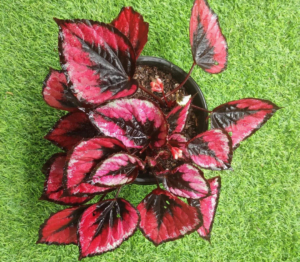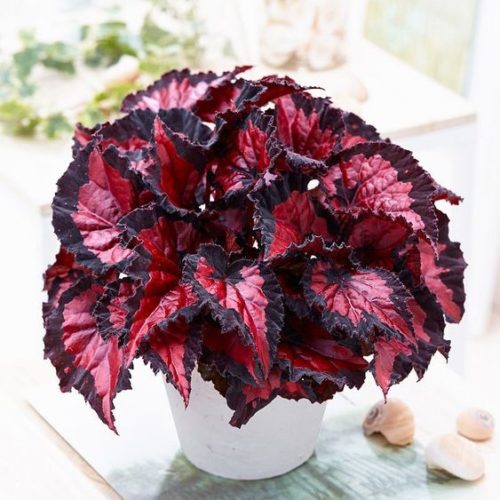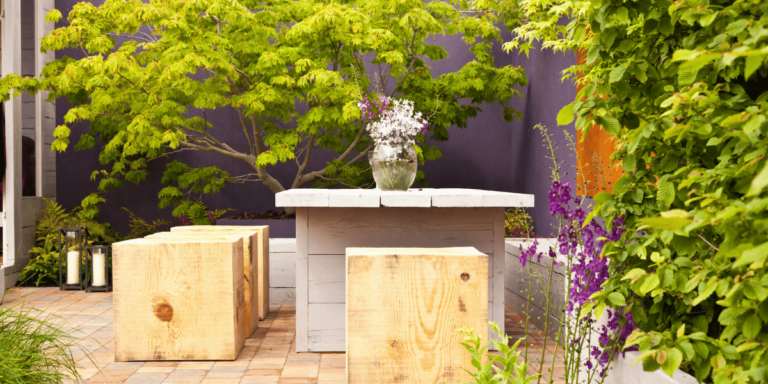Introduction
Indoor plants have been the toast of interior decorating and gardening circles for decades, and none have been as much adored as the Rex Begonia. With its vividly colored leaves and intricate patterns, the Rex Begonia isn’t just any indoor plant – it’s a living piece of art. In this review, we’ll delve deep into understanding this plant, from its basic care to troubleshooting issues, ensuring that even a novice gardener can revel in its beauty with confidence.
Rex Begonia Indoor Plant Details
| Specification | Details |
|---|---|
| Common Names | Rex Begonia, Painted-Leaf Begonia, Fancy-Leaf Begonia |
| Botanical Name | Begonia rex |
| Family | Begoniaceae |
| Plant Type | Herbaceous perennial |
| Mature Size | Typically 12-24 inches in height and 12-18 inches in spread |
| Sun Exposure | Bright, indirect light |
| Soil Type | Well-draining soil mix with peat moss, pine bark, and perlite |
| Soil pH | Slightly acidic to neutral (6.0 to 7.5) |
| Bloom Time | Rarely blooms indoors, but if it does, usually in late winter |
| Flower Color | Pink to white, but primarily grown for its colorful foliage |
| Hardiness Zones | Typically grown as a houseplant; outdoor zones 10-11 |
| Native Area | Eastern India |
The Rex Begonia, as illustrated in the table, is known for its striking, colorful foliage more than its blooms. Native to Eastern India, it has adapted beautifully as a favored indoor plant worldwide. Its specific care requirements, from light to soil type, contribute to its captivating appearance, ensuring it remains a beloved feature in many homes.
Plant Care
Caring for a Rex Begonia is like tending to a precious piece of art. Its requirements may seem specific, but with the right tools and guidance, it’s a joy to cultivate. Nurturing this plant is a testament to patience and a soft touch, and the rewards are visually spectacular.
Light Requirements
The Rex Begonia flourishes in bright, indirect light. Direct sunlight can scorch its beautiful leaves, causing them to lose their vibrancy. If you notice the leaf colors becoming dull or pale, it might be receiving too much light. Conversely, if the plant isn’t getting enough light, it will exhibit slow growth and reduced leaf coloration. A sheer curtain in front of a window or placing it in a spot that receives dappled light is ideal.
Soil Preferences
This indoor marvel prefers a well-draining soil mix, which prevents root rot – a common concern for many indoor plants. A mix containing peat moss, pine bark, and perlite often serves the Rex Begonia well. Ensuring the pot has adequate drainage holes is also a key to its thriving environment.
Watering Practices
The Rex Begonia has a preference for a moderate watering routine. It’s important to water the plant when the top inch of the soil feels dry to the touch, but never let it sit in water. Overwatering can lead to root rot, while underwatering may cause the leaves to droop and appear dehydrated.
Temperature and Humidity
A tropical delight, Rex Begonia thrives in warm temperatures, preferably between 65°F to 75°F. It loves humidity, so a humidifier or a pebble tray filled with water placed nearby can provide the moisture it craves. If the edges of the leaves start to brown, it’s a sign the plant desires more humidity.
Fertilizer
To maintain its vibrant foliage, feed the Rex Begonia with a balanced, water-soluble fertilizer diluted to half strength every two weeks during the growing season. In the dormant winter months, reduce fertilization to once a month.
Pruning Techniques
Pruning isn’t just about maintaining a shape; it’s about encouraging healthier growth. For the Rex Begonia, removing old or damaged leaves ensures that the plant focuses its energy on new growth. Using sterilized scissors, cut at the base of the unwanted leaf, being careful not to damage the main stem.
Overwintering Tips
As winter approaches, the Rex Begonia goes into a state of dormancy. While it still requires care, it’s best to water it less frequently and ensure it’s kept away from cold drafts. A stable environment with consistent temperatures is vital during these colder months.
Propagating the Rex Begonia
Propagation of this plant is a delightful process. Leaf cuttings are the most common method. By simply cutting a healthy leaf with a piece of its stem attached and placing it in water or soil, you’ll witness the birth of a new Rex Begonia over time.
Recognizing and Addressing a Quickly Declining Plant
No plant enthusiast wants to see their Rex Begonia deteriorate. Common signs of distress include drooping leaves, yellowing, or brown tips. By identifying the root cause, be it water, light, or pests, you can revive the plant back to its radiant self.
Types of Rex Begonia
The Rex Begonia isn’t just a singular entity. It boasts a variety of types, each one presenting its unique flair and coloration:
- Escargot: Recognized by its snail-like spiral at the base of each leaf.
- Fireworks: This variety stands out with its silver leaves and vibrant purple-pink patterns.
- River Nile: Green with a hint of silver and red, its serrated leaves create an intricate look.
- Maurice Amey: This one stuns with a blend of pink, green, and silver in its foliage.
Regardless of the type, each brings its distinct charm to the indoor garden, making Rex Begonia a versatile choice for enthusiasts.
Common Pests & Plant Diseases (with Solutions)
Rex Begonia, despite its beauty, isn’t immune to pests and diseases:
- Pests:
- Spider Mites: These tiny arachnids can cause leaves to yellow and drop. Solution: Regularly mist your Rex Begonia to increase humidity, which deters mites. If infestation occurs, use insecticidal soap.
- Aphids: Tiny green or black bugs that suck the sap, causing the plant to weaken. Solution: Remove them manually or use a natural insecticidal spray.
- Diseases:
- Powdery Mildew: White, powdery spots on leaves. Often due to high humidity and poor air circulation. Solution: Ensure good ventilation, prune infected leaves, and consider fungicidal treatments if severe.
- Root Rot: Caused by overwatering and poor drainage. Solution: Ensure the pot has drainage holes, and use a well-draining soil mix.
Encouraging Your Rex Begonia to Bloom
While Rex Begonia is primarily grown for its foliage, it can produce flowers. To coax your plant into blooming:
- Provide Adequate Light: While the plant doesn’t like direct sunlight, ensuring it gets bright, indirect light can stimulate blooming.
- Fertilization: Using a balanced fertilizer can provide the necessary nutrients for it to bloom.
- Maintain Consistent Care: Keeping up with its water, temperature, and humidity needs can encourage the plant to produce flowers.
Common Problems With Rex Begonia
While Rex Begonia is a visual delight, it may sometimes present challenges:
- Yellowing Leaves: This can indicate overwatering or excessive light.
- Drooping Leaves: A sign of either underwatering or overwatering.
- Brown Leaf Edges: Often a result of low humidity or excessive fertilization.
- Stunted Growth: This can be due to inadequate light or an insufficient nutrient supply.
Understanding these common issues and addressing them promptly can ensure that your Rex Begonia remains the jewel of your indoor garden.
In summary, the Rex Begonia, with its myriad of types and intricate foliage, demands attention and specific care. But as any enthusiast will tell you, the rewards, both visual and experiential, are well worth the effort. Whether you’re addressing pests, diseases, or aiming to induce blooming, knowing the ins and outs of this plant can lead to a fulfilling gardening journey.
Final Reflections on the Rex Begonia
The Rex Begonia, with its unparalleled beauty, is a testament to nature’s artistry. While it demands attention and specific care, the joy it brings to indoor gardeners is immeasurable. With its flamboyant foliage and its resilience, it’s a plant that promises to be a conversation starter in any home.
Frequently Asked Questions
Decode the magic of gardens with our guide to Landscaping Styles Frequently Asked Questions.
- Typically, repotting every 2-3 years is adequate, or when you notice the roots outgrowing the pot.
- While primarily an indoor plant, it can thrive outdoors in shaded areas, but only in warmer climates
- Brown edges often indicate low humidity. Consider increasing the moisture around your plant..
Yes, the Rex Begonia can be harmful if ingested by pets. It’s best to keep it out of their reach.













